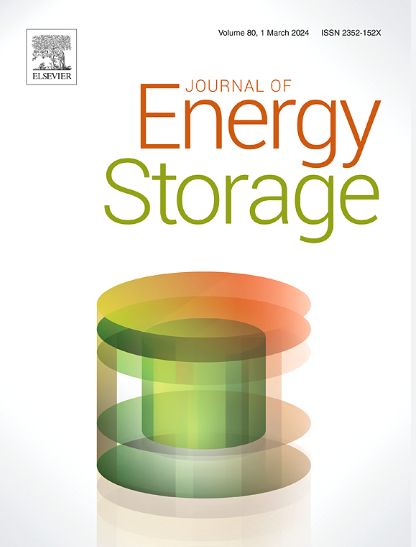Preparation and properties of stearic acid–palmitic acid-based shaped composite phase change materials
IF 8.9
2区 工程技术
Q1 ENERGY & FUELS
引用次数: 0
Abstract
Phase change materials (PCM) are pivotal in addressing the inherent intermittence and instability in solar heating applications by providing effective energy storage. A novel shaped PCM is fabricated by integrating modified graphite into a composite PCM substrate, using expanded graphite (EG) as a support, and modifying it with myristic acid to form modified exfoliated graphite (MEG), followed by melt blending and infiltration. The optimal mass ratio of the composite binary eutectic PCM—palmitic acid (PA) and stearic acid (SA) modified with 0.5 wt% of MEG (PA–SA/MEG0.5)—to EG is determined to be 11:1, achieving an ideal composite density of 750 kg/m3. The PSMEEG750 material, composed of PA, SA, MEG, and EG at a shaping density of 750 kg/m3 shows melting and solidification temperatures close to PA–SA, at 54.06 °C and 53.68 °C, respectively. However, its latent heats are slightly smaller (182.80 J/g and 177.70 J/g) compared to PA–SA. Notably, the thermal conductivity of PSMEEG750 is 20.8 times greater than PA–SA, reaching 5.63 W/(m∙K), with a 17.2 % increase in specific heat capacity. After 1000 thermal cycles, the phase change latent heat of PSMEEG750 only decreases by 4–4.5 %, indicating excellent leak prevention, heat storage capability, and thermal cycle stability. When integrated into solar heating systems and validated through Fluent software simulations, PSMEEG750 requires less time to reach the heat storage plateau compared to PA–SA, with a relative increase in heat storage time of 26.39 %. Thus, PSMEEG750 is a promising material for medium- and low-temperature solar phase change thermal energy storage systems.
硬脂酸-棕榈酸基异型复合相变材料的制备及性能研究
相变材料(PCM)是解决太阳能加热应用中固有的间歇性和不稳定性的关键,它提供了有效的能量储存。将改性石墨集成到复合PCM衬底中,以膨胀石墨(EG)为载体,用肉豆酱酸对其进行改性,形成改性剥落石墨(MEG),然后进行熔体共混和浸渍,制备了一种新型形状PCM。经0.5 wt%的MEG (PA - SA/MEG0.5) - EG改性后的二元共晶pcm -棕榈酸(PA)和硬脂酸(SA)复合材料的最佳质量比为11:1,达到750 kg/m3的理想复合密度。在成型密度为750 kg/m3时,PA、SA、MEG和EG组成的PSMEEG750材料的熔化和凝固温度分别为54.06℃和53.68℃,接近PA - SA。潜热为182.80 J/g和177.70 J/g,略低于PA-SA。值得注意的是,PSMEEG750的导热系数是PA-SA的20.8倍,达到5.63 W/(m∙K),比热容增加17.2%。经过1000次热循环后,pmeeg750的相变潜热仅下降4 - 4.5%,具有良好的防泄漏、储热能力和热循环稳定性。当集成到太阳能加热系统中并通过Fluent软件仿真验证时,与PA-SA相比,PSMEEG750达到蓄热平台所需的时间更短,相对增加了26.39%的蓄热时间。因此,pmeeg750是一种很有前途的中低温太阳能相变储能系统材料。
本文章由计算机程序翻译,如有差异,请以英文原文为准。
求助全文
约1分钟内获得全文
求助全文
来源期刊

Journal of energy storage
Energy-Renewable Energy, Sustainability and the Environment
CiteScore
11.80
自引率
24.50%
发文量
2262
审稿时长
69 days
期刊介绍:
Journal of energy storage focusses on all aspects of energy storage, in particular systems integration, electric grid integration, modelling and analysis, novel energy storage technologies, sizing and management strategies, business models for operation of storage systems and energy storage developments worldwide.
 求助内容:
求助内容: 应助结果提醒方式:
应助结果提醒方式:


